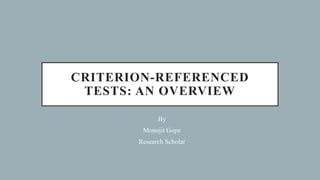
Criterion Reference Tests.pptx
- 1. CRITERION-REFERENCED TESTS: AN OVERVIEW By Monojit Gope Research Scholar
- 2. DEFINITION OF (CRT) Criterion-referenced tests (CRT) are assessment tools designed to measure an individual's performance against pre-established criteria or standards. Unlike norm-referenced tests that compare individuals to a norm group, CRTs focus on determining whether an individual has achieved mastery or competency in specific skills or knowledge areas. The scores on CRTs are typically reported as "pass/fail," "meets criteria," or on a performance continuum aligned with the predetermined criteria. CRTs are used to assess an individual's proficiency or mastery of specific content and provide targeted feedback for improvement and decision-making purposes.
- 3. KEY CHARACTERISTICS OF CRTS Focus on mastery of specific criteria or skills. Scores reported as "pass/fail," "meets criteria," or on a performance continuum. Emphasis on absolute mastery rather than comparison to others.
- 4. TEST DEVELOPMENT AND ALIGNMENT Process of defining criteria and performance levels. Aligning test items and tasks to the defined criteria. Ensuring content validity and alignment with instructional goals.
- 5. TEST ADMINISTRATION AND SCORING Procedures for standardized administration to maintain consistency. Objective and reliable scoring methods. Determining the cut-off scores or performance levels for mastery.
- 6. INTERPRETATION OF CRT SCORES Direct interpretation of scores in relation to predetermined criteria. Identification of specific areas of strength or weakness. Feedback on individual performance for targeted improvement.
- 7. ADVANTAGES OF CRTs Focus on specific skills or knowledge areas. Clear determination of mastery or competency levels. Tailored feedback for individual growth and improvement.
- 8. LIMITATIONS OF CRTs Limited information on relative performance compared to others. Difficulty in comparing scores across different CRTs. Potential biases in defining criteria or performance levels.
- 9. EXAMPLES OF CRTs Common uses of CRTs in education, training, and certification. Examples of well-known CRTs (e.g., driver's license test, language proficiency exams).
- 10. BEST PRACTICES IN USING CRTs Clearly define criteria and performance levels. Align test items with the defined criteria. Use CRT scores in conjunction with other assessment measures for a comprehensive evaluation.
- 11. PURPOSE OF CRTs Determine mastery or proficiency in specific skills or knowledge areas. Provide targeted feedback for improvement. Guide instructional decision-making. Evaluate curriculum and program effectiveness. Support certification and licensing requirements.
- 12. SIGNIFICANCE OF CRTs Focuses on mastery and proficiency. Provides clear criteria for evaluation. Tailors feedback and instruction to individual needs. Supports objective decision-making. Ensures alignment with standards and requirements.
- 13. HOW DO CRITERION-REFERENCED TESTS WORK Criterion-referenced tests are scored by comparing a student's performance to a set of predetermined criteria. The criteria are typically defined in terms of the knowledge or skills that the student is expected to have mastered. The student's score is then based on whether or not they have met the criteria.
- 14. WHEN SHOULD CRITERION-REFERENCED TESTS BE USED Criterion-referenced tests should be used when it is important to measure student learning in a direct way. Criterion-referenced tests should not be used to make decisions about students that are not based on their actual learning.
- 15. DIFFERENT BETWEEN NRTs AND CRTs Feature Norm-Referenced Test Criterion-Referenced Test Purpose To compare test takers to each other To measure a test taker's mastery of a specific set of skills or knowledge Scoring Based on a comparison to a norm group Based on a predetermined standard of performance Results Percentile rank, standard score, or grade equivalent Pass/fail, mastery/non-mastery, or other categorical designation Use To make decisions about admissions, placement, or other high-stakes outcomes To track student progress, identify areas of need, or inform instruction
- 16. CONCLUSION Criterion-referenced tests are a valuable tool for assessing student learning. However, it is important to be aware of the limitations of these tests and to use them in a responsible way.
- 17. THANK YOU
